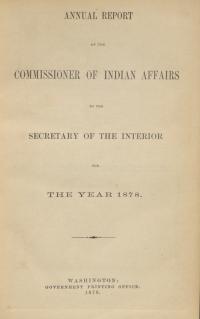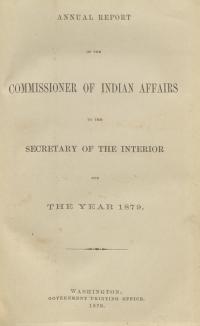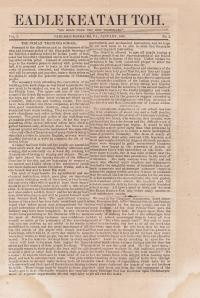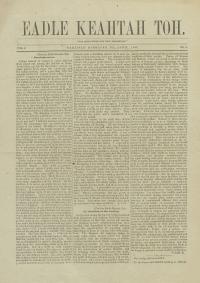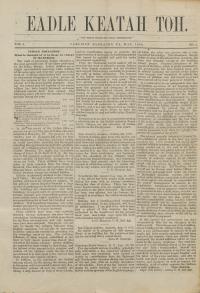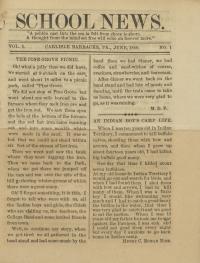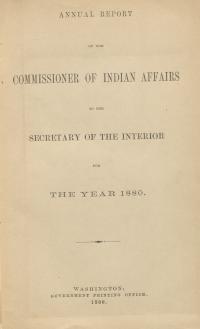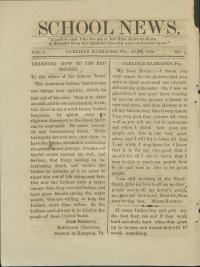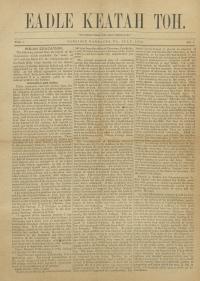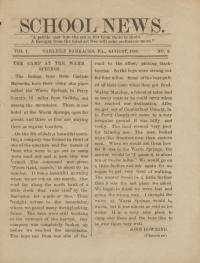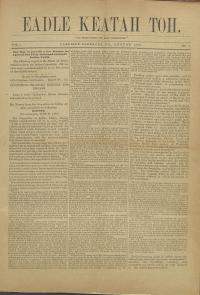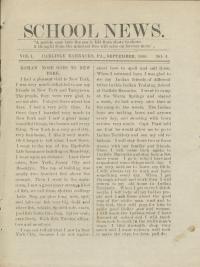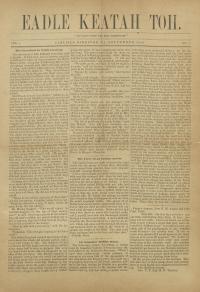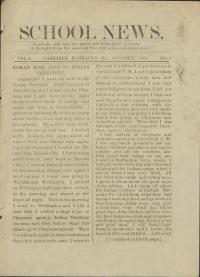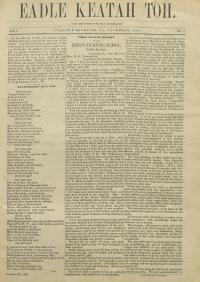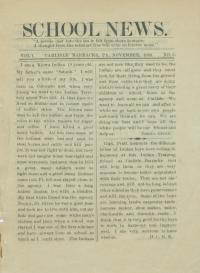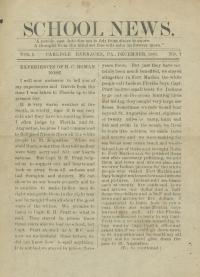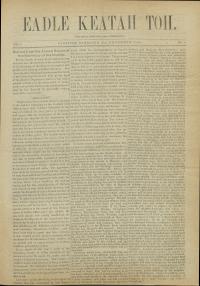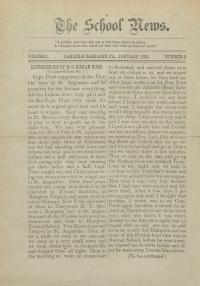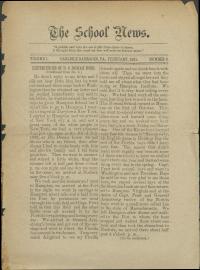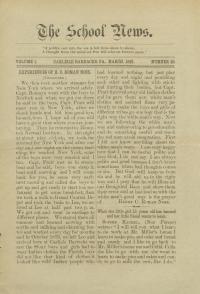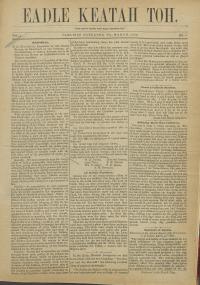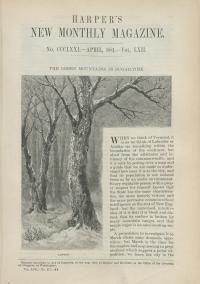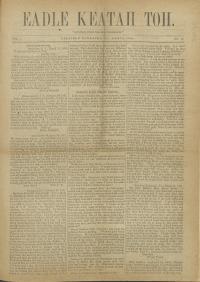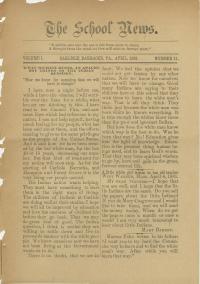The Publications section features newspapers, magazines, and souvenir pamphlets that reflect the activities of the Carlisle Indian School and its students. Many of the newspapers and magazines included here, such as The Indian Helper and The Red Man, were produced at the school by the students themselves, who were developing the skills of printing and typesetting.
This section of the website does not include brochures, broadsides, or programs for public events. Shorter printed pieces such as these are found in the Documents section of the website.
Search Publications
Please Note: The Search box above only searches Publications. To search the entire site, use the search box on the top left.
You are searching the title, author, description, and location fields. File attachments are not searched.
Browse Publications
An excerpt from the Annual Report of the Commissioner of Indian Affairs to the Secretary of the Interior for the fiscal year ending 1878, containing reports on the Indians at the Hampton Institute and a report by Lieut. Richard Henry Pratt regarding the recruitment of students for that school.…
Format: Book
Repository: Dickinson College Archives & Special Collections
An excerpt from the Annual Report of the Commissioner of Indian Affairs to the Secretary of the Interior for the fiscal year ending 1879, containing the Commissioner's report on Indian education. That report discusses the founding of the Carlisle Indian School under the command of Richard Henry…
Format: Book
Repository: Dickinson College Archives & Special Collections
The first page opened with an article titled "THE INDIAN TRAINING SCHOOL," that described the progress of the school, its Christian methods, the work of the former Ft. Marion prisoners of war preparing buildings for use, the importance of the town Sunday Schools, the school curriculum that…
Format: Newspapers
Repository: National Archives and Records Administration
Page one opened with a teacher identified as A.J.S. (Alfred J. Standing) reminiscing about his time teaching Native Americans before he came to Carlisle. Also on the page was an article signed by "G. Le R. B." (George Le Roy Brown) on the civilization of the Indians, comparing it to the…
Format: Newspapers
Repository: Dickinson College Archives & Special Collections
Page one opened with information, including statistics, from the Annual Report of the Commissioner of Indian Affairs about Carlisle and other schools as reported by Indian agents. Page two contains more arguments for, and accounts of support for, educating Indian youth. The article "Our Dining…
Format: Newspapers
Repository: Cumberland County Historical Society
The first article by M. D. P. [Mason D. Pratt] describes a field trip to an iron forge near Pine Grove, followed by a picnic at the grove with the students, teachers, visiting chiefs, the college band and some invited guests. “An Indian Boy's Camp Life,” by Henry C. Roman Nose, gives a short…
Format: Newspapers
Repository: Cumberland County Historical Society
An excerpt from the Annual Report of the Commissioner of Indian Affairs to the Secretary of Indian Affairs for the fiscal year ending 1880, containing the first annual report of the Carlisle Indian School. The report discusses the school's opening, recruitment of students, educational and…
Format: Book
Repository: Dickinson College Archives & Special Collections
The first article is by John Downing (Cherokee), titles “Learning How to Use Bad Things.” In which he writes about alcohol and the benefits of being nice to the people of the United States, and a letter from Moses Nonway to his mother asking on the health of his people and reflecting on their…
Format: Newspapers
Repository: Cumberland County Historical Society
Page one had an article on the benefits all children of the Sioux Nation receive from the agency, and how adult should have the opportunity to learn English as well. There was statistics on the number of children attending, and the ratio of boys to girls. Page two had a piece about the student’s…
Format: Newspapers
Repository: Cumberland County Historical Society
An excursion to Warm Spring opened this edition, titled “The Camp at the Warm Springs” by John Downing (Cherokee). They hiked all day until they reached the Springs, picking black berries along the way and at one point believing they had gotten lost. This proceeded an editorial on the benefits…
Format: Newspapers
Repository: Cumberland County Historical Society
Page one had a report on a bill that would “increase educational privileges and establish industrial schools for the benefit of youth belonging to such nomadic Indian tribes as have educational treaty claims upon the United States.” It also talked about the creation of the Carlisle Industrial…
Format: Newspapers
Repository: Cumberland County Historical Society
The opening piece was written by Roman Nose, titled “Roman Nose Goes to New York,” and it tell of his trip to New York City, visiting the Equitable Life Insurance Building and the aquarium, and the follows few weeks after his trip. He was one of the students who went on the Warm Springs trip…
Format: Newspapers
Repository: Cumberland County Historical Society
Page one opened with the discovery of a Cherokee tribe in the mountains of South Carolina and how they begged for teaches when the white travelers passed through their village. The Indian bow and white man musket were also compared on page one, with the bow being determined to be the superior…
Format: Newspapers
Repository: Cumberland County Historical Society
The fifth issue opens with Roman Nose describing his trip back to Indian Territory and his reunion with his family. While there he expresses his enjoyment of the school and the benefits of education, eventually convincing the chiefs to sends twenty-one Cheyenne children and Ten Arapahoe children…
Format: Newspapers
Repository: Cumberland County Historical Society
Page one had a report on the first year of operation of the Carlisle Industrial School, mentioning when students arrived, how many and where from. Also it described several trades the students were learning what how they were learning them. Page two had information about the Menomonee Agency and…
Format: Newspapers
Repository: Cumberland County Historical Society
The first page has a short narrative from Joshua Given (Kiowa) on how he went from living in Indian Territory to studying at Carlisle and a brief paragraph from H.C. Roman Nose on how well and enthusiastically the students are learning. The editorial was about how smart Indians started to learn…
Format: Newspapers
Repository: Cumberland County Historical Society
Issue Seven opens with Roman Nose explaining how he came to Carlisle after being held captive in St. Augustine for three years. He explains his time there was good because of the kindness of Capt. Pratt. After the editorial about the benefits of speaking English, there was a small letter from a…
Format: Newspapers
Repository: Cumberland County Historical Society
Page one started with an explanation for why boarding schools are necessary to successfully educate Indian children. It was explained that day school simply “do not withdraw the pupils from the influences of their home surroundings in such a manner us to facilitate a change in their habits of…
Format: Newspapers
Repository: Cumberland County Historical Society
Issue Eight opens with a continuation of Henry C. Roman Nose’s journey from St. Augustine, to New York city and eventually Tarrytown, New York. The next page was an editorial on the importance of Hard Work, and how Indians should strive to work hard like White men do, along with a series of…
Format: Newspapers
Repository: Cumberland County Historical Society
Issue nine, continues Roman Nose’s story, showing him attending Hampton School and eventually traveling to Lee, Ma. This issue’s editorial featured a piece on the hopes that the new U.S. President Garfield will put all Indian children in school. On the same page Robert W. Stewart (Creek) wrote…
Format: Newspapers
Repository: Cumberland County Historical Society
It opens with the conclusion to Roman Nose’s long journey to Carlisle. He explained how at Lee he learned to mow with a scythe and milk cows, before travelling to Carlisle Barracks, where he was happy to see other Indians following the “white man’s way”. Also on the first page is a small bit…
Format: Newspapers
Repository: Cumberland County Historical Society
[Note: Although the front page gives the date of printing as March 1880, this issue came out in March 1881.]
Page one had a list of requests to the United States President from W. E. Dodge, Howard Crosby, John Hall, S. M. Moore, W m. C. Gray, S. It. Riggs, and T. M. Sinclair, making…
Format: Newspapers
Repository: Cumberland County Historical Society
A description of this article is not currently available.
"Indian Education at Hampton and Carlisle," Harper's New Monthly Magazine 62, no. 320 (April 1881): 659-675.
Format: Magazines
Repository: Dickinson College Archives & Special Collections
Page one opened with a letter to Carlisle from “An Old Soldier” who had been stationed at the Carlisle Barracks forty years earlier. There were also three other letters to residents of the school from Peter Primaux, Paul C.T., and Arizona Jackson. The rest of the page was one to two sentence…
Format: Newspapers
Repository: Cumberland County Historical Society
The opening article was written by Michael Burns (Apache), and focused on “The Indian Question.” In it he explains how many Indians falsely believe that white men are wiser simply because they are born white, and argues that their wisdom comes not from their skin color, but from more easily…
Format: Newspapers
Repository: Cumberland County Historical Society

